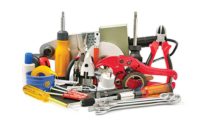It’s that time of the year when we’re supposed to get ready to make a resolution or two that will last a few weeks until we slouch back into our usual routines. You know how it goes. The stationary bike sure makes for a great clothes hanger, doesn’t it?
If you’re struggling to come up with something other than giving up things that you love, consider adopting one of these trade-related resolutions instead. And let me know how you make out.
Some suggestions
Find a young person and teach her or him something that took you a long time to learn. How well you’re able to stick with this resolution will depend on whether or not you’ve actually taken the time to learn stuff. Some people begin life thinking they already know it all. I hope you’re not one of those people, but if you are, please skip this resolution. The young person you’re talking to won’t want to listen to you anyway.
Go talk to a coot. Find an old person who has learned a thing or two over the generations. Gender doesn’t matter here. Just find one that’s older than dirt and ask open-ended questions. What’s the oldest control you ever saw? Who taught you the most during your career? What’s the toughest thing you ever had to learn? What’s the worst thing you ever did on a job? What advice would you give someone my age?
Ask, and then shut up. Just listen. This is a great resolution because few people have the time or the patience to listen to coots. The coots you choose will appreciate every question. And if you ask the right questions, you’re going to learn things most people don’t know. We need to look backward to see forward. We need to listen more, especially to the coots.
Do something thoughtful. When you’re on an early service call and you see the newspaper out there on the sidewalk or under the car’s bumper in the driveway, pick it up and bring it into the house with you. Old people appreciate things like this. And if it’s a newspaper you’re picking up, you can bet it will be an old person answering that door. Coots are the only one’s reading things made from paper these days. Also, move the kid’s bicycle if it’s in the driveway behind the car. A young person will answer that door. He or she will be staring at a screen when you first meet them. That screen is a part of their anatomy. Don’t let it trouble you. Oh, and don’t mention that you moved the bike. The kid might get in trouble.
Stop tailgating. I know you’re in a hurry, but you’re probably going to arrive at the next red light at the same time as the person you’ve been tailgating. Tailgating is bad for business. This is because you’re probably in a vehicle that has your company’s name, address, phone number and website plastered all over it. When that light turns green, you’re going to soar around that person you’ve been tailgating and maybe even cut back in when you’re this close to their bumper. That person is going to remember you.
That person is going to tell everyone they meet about how you put both of your lives in jeopardy. And who knows, maybe the person you tailgate will even post a video on YouTube. It will be all about you and your truck. Cars have cameras in them these days. Did you know that? That guy might even write a magazine column about you. You never can tell who that stranger in the other car might be, so do this instead: Drive like your kids are in that other car.
Alter your reading habits. Spend 30 minutes less on social media each day and use that
time to read a few trade magazine articles, or a chapter in a book that’s going to help you become a better troubleshooter or a more successful businessperson. Sure, you’ll be less informed about what your friends are eating for lunch today, and for the next half-hour you won’t know who’s fighting with whom on Facebook. That’s tragic, right?
I understand the fear of being left out. But I also know that if you shut it down for just 30 minutes a day and read something that will help you grow, you’re going to be happier. Shut it off and learn. The Lovely Marianne and I once went on a Caribbean cruise. We spent a whole week without phone, internet or news. We read books. We talked to each other. We talked to people we will never see again. We looked at the sea and sky, and we marveled at how tiny and fragile we are all. It was nice. Try it.
Become a better explainer. If you have kids, they can help you with this. If you don’t have kids of your own, borrow someone else’s kids for a while. Sit with them and explain how a radiator works, being sure to use terms of simple English and analogies they can understand. Turn that radiator into a story. Everyone loves a good story. Then do the same thing with a boiler. Bring it to life. When I was doing seminars, I talked about how British Thermal Units commuted on the water like passengers on a train. They lived in the boiler and worked in the radiators. A certain amount of them would get off at each radiator and get to work warming the room.
That’s how I brought Delta-T to life for the people at my seminars. I described how these British Thermal Units wore tweed suits and bowler hats. Hey, they’re British, right? And each Btu carried an umbrella because it was wet on that train. Our young daughters laughed at me when I told them about this. So did the people at the seminars. But they all got it. They all saw the world and the technology in a new way. Strive to speak in simple terms. Your customers will appreciate that. Simplicity sells.
The power of a dollar
Give a buck. Everyone in the trades enjoys getting a tip for doing great work. It’s a bonus you didn’t expect (or maybe you did). You showed up and worked in a tight spot under tough conditions. You earned that tip. It made your life a bit easier. Here’s one last resolution that may or may not appeal to you. It all depends on how you look at life. The next time a homeless person asks you for a buck, just give it. Not having that buck in your wallet won’t change your lifestyle, will it? So give it and then pay close attention to what happens in the days ahead. That buck is going to come back to you in many ways.
The Cross Bronx Expressway is one of the most congested roads in New York City. It also includes the most-expensive single mile of road ever constructed in America ($40 million in 1948). If you enter New York City from New Jersey via the George Washington Bridge you’ll get to drive that mile. Along the way, you may see an older man standing on that expressway. He’s hard to miss. He balances on the line between the right and center lanes. He’s holding a piece of brown-cardboard with the words, “I’m homeless. Please help.” He’s smiling and waving at the drivers. He’s able to do this because, most of the time, the cars and trucks are moving slower than he can walk. What’s tough to figure, though, is how he got there.
hat expensive mile is at the bottom of a deep, dynamited canyon with no walkways and no nearby entrance or exit ramp. He might as well be on the moon. How did he get there? If you ever pass that guy, give him a buck simply because he’s there. Don’t worry about what he’s going to do with that buck. Just give it to him because he’s courageous. He’s doing something desperate and for reasons I hope you and I will never have to experience. And he’s smiling in spite of it all, no matter the weather. The guy is smiling.
And who knows? He may have nail holes in his feet. You never can tell. Happy New Year.





